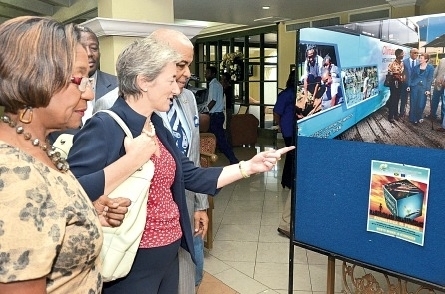IF a hurricane were to hit Jamaica today, the island would fare much better than it would have three years ago.
This is according to reports from the Government of Jamaica, the European Union (EU) and the United Nations Environment Programme, which together replanted 405 hectares of degraded forest land, 20 acres of seagrass beds, seven hectares of mangrove forests, and installed 150 artificial reef structures at vulnerable areas across the island such as Portland Cottage in Clarendon, Negril in Westmoreland, and Hellshire in St Catherine.
Trees keep soil intact during rain, thus preventing landslides and run-off, with sea grass operating in much the same way, but at sea. Reefs and mangroves, meanwhile, are known for acting as buffers against waves and protecting the shoreline from erosion.
The project — Climate Change Adaptation and Disaster Risk Reduction — was carried out over a three-year period, staring in October 2010, and coming to a formal end yesterday. It cost almost 4.5 million euro, the lion’s share of which was put up by the EU.
Its objective was to help Jamaica be able to adapt to climate change and to contribute to sustainable development by improving the resilience of vulnerable areas by reducing the risks brought by natural hazards.
“The initiative was a home-grown representation of a national response to an issue which, if not addressed, threatens the achievement of our national development goals,” deputy director general of the External Corporation and Management at the Planning Institute of Jamaica (PIOJ) Barbara Scott said yesterday.
Further, she said, it was a model of the joined-up approach to governance, given that multiple government agencies were involved — PIOJ, the Forestry Department, the National Environment and Planning Agency, the Meteorological Service of Jamaica and the Environment Management Division of the Ministry of Land, Water and Climate Change.
Head of the EU Delegation in Jamaica Paola Amadei applauded the achievements of the project, and expressed a desire to see them preserved over time.
“Sustainable growth, which will benefit us and our children and the children of our children, is one which is not based on the ill-fated alternative between development and environmental protection as the two go hand-in-hand,” she said.
“Disasters trap people into poverty. Unless we act now, we will see more and more disasters due to unplanned development and environmental degradation affecting, in particular, the poorest in society.
Also numbered among the climate change disaster risk reduction project’s successes are the river protection and shore restoration works, the development of eco-tourism and sustainable livelihood projects centred on bee-keeping, organic farming, royal palm nursery planting and Irish moss harvesting, and the planting of 450 seedlings in nurseries.
“And remember that a seedling is a potential tree, which is potential food, which is potential timber,” said deputy director general, Sustainable Development and Regional Planning at the PIOJ, Claire Bernard
Regarding the livelihood projects, she said there were 14 in total, with 700 direct beneficiaries.
Other achievements she named were the establishment of local forest management committees, a forest fire management programme, an agro-forestry programme, and management plans for marine protected areas. There was also capacity building through training, the installation of climate equipment, the drafting of a cays policy, an integrated coastal zone management policy, and a climate change policy framework, for which a green paper was tabled in Parliament last month.
It was important work, according to Amadei, who pointed out that two-thirds of Jamaica’s population live in coastal areas and that 75 per cent of Jamaica’s industries and services — which generate some 90 per cent of GDP — are located within two kilometres of the coast.
“Protecting what is the basis for [the] livelihood of thousands of people is not a luxury. It is a necessity,” she said.
Environment Minister Robert Pickersgill said he had participated in some of the events under the project and was impressed with “the practical measures taken to increase our resilience and the clear messages about climate change in scientific terms”.
“Let me say well done to all the partners, as well as the numerous stakeholders who worked tirelessly to achieve its objectives,” he said yesterday, calling the project a success.











